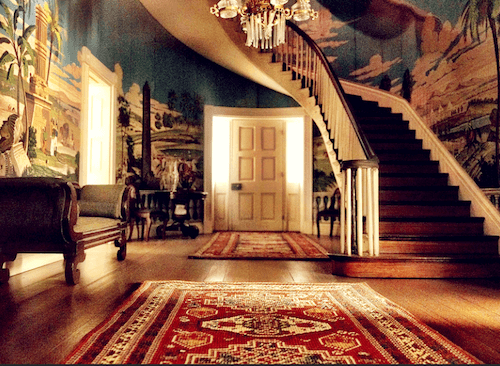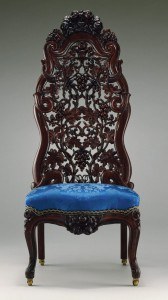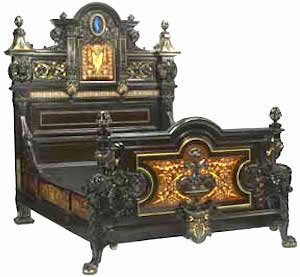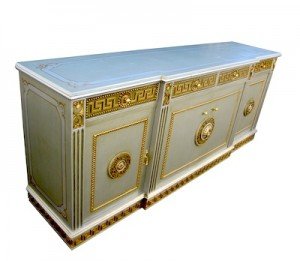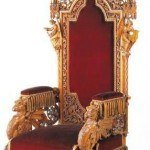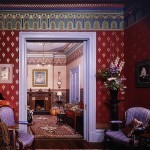Mid-Victorian Furniture
Mid-Victorian furniture design continued the practice of reviving and blending old styles. Add to that, increased world trade introduced middle-eastern and Asian elements to the mix. No particular style dominated. Rather, furniture designers drew inspiration from Elizabethan, Neoclassical and other periods. And it could all be done with machines.
The furniture displayed at the The Great Exposition of 1851showed what could be massed produced to satisfy the growing middle class. Cheaply. Very little custom work was exhibited at the Crystal Palace. Taste in furniture would remain the same until the late Victorian era when it was back to basics with the Arts and Crafts style. Following are the five most popular furniture styles of the mid-Victorian era:
Elizabethan, 1850-1915
This sub-category of the Victorian era is probably the most feminine-influenced style. It also makes use of the new machine-turned spools and spiral profiles that were fast becoming popular with furniture makers. New technology advancements allowed more machined parts to be generated. By adding flowers, either carved or painted, the furniture pieces of this era had a softness to them. Chair backs tend to be high and narrow, having a slight back tilt. Legs vary from straight to baluster-turned forms to spindle turned. This period of furniture design saw more usage of needlework upholstery and decoratively painted surfaces.
Louis XVI, 1850-1914
One period of the Victorian era that flies away with straight lines is Louis XVI. However, this furniture style is not austere; it is adorned with ovals, arches, applied medallions, wreaths, garlands, urns and other Victorian flourishes. As the period aged, more ornamentation became present on the finished furniture styles. Furniture of this time was made from more expensive woods, such as ebony or rosewood. Walnut was popular around the 1890s. Other dark woods were featured, often to contrast the lighter ornaments. Expect to find straight legs or fluted and slightly tapered legs.
Naturalistic, 1850-1914
This furniture period takes the scrolling effects of the Rococo Revival designs and adds more flowers and fruits to the styles. More detail is spent on the leaves―so much that
one can tell if they are to represent grape, rose or oak leaves. Technology advances enhanced this design style, as manufacturers developed a way of laminating woods together. This layered effect was achieved by gluing thin layers together, with the grains running at right angles on each new layer. The thick panels created were then steamed in molds to create the illusion of carving. The woods used as a basis for the heavy ornamentation were mahogany, walnut, and some rosewood. The upholstery of this period is often tufted, eliminating any large flat surface. The name of John Henry Belter is often connected with this period, for it was when he did some of his best design work. John and Joseph W. Meeks also enjoyed success with laminated furniture. Original labels bearing these names are sometimes found on furniture pieces from this period, giving further provenance.
Renaissance Revival, 1850-1880
Furniture made in this style period reflects how cabinetmakers interpreted 16th- and 17th-century designs. Their motifs range from curvilinear and florid early in the period to angular and almost severe by the end of the period. Dark woods, such as mahogany and walnut, were primary with some use of rosewood and ebony. Walnut veneer panels were a real favorite in the 1870s designs. Upholstery, usually of a more generous nature, was also often incorporated into this design style. Ornamentation and high relief carving included flowers, fruits, game, classical busts, acanthus scrolls, strapwork, tassels, and masks. Architectural motifs, such as pilasters, columns, pediments, balusters, and brackets, are another prominent design feature. Legs are usually cabriole or have substantially turned profiles.
Néo-Greek, 1855-1885
This design style easily merges with both the Louis XVI and Renaissance Revival. It is characterized by elements reminiscent of Greek architecture, such as pilasters, flutes, column, acanthus, foliate scrolls, Greek key motifs and anthemion high-relief carving. This style originated with the French but was embraced by American furniture manufacturers. Woods are dark and often ebonized. Ornamentation may be gilded or bronzed. Legs tend to be curved to scrolled or cloven hoof feet.
Thanks to Antique Trader for help with this article.
All photos used in this post are of real furniture. I prefer to use dollhouse miniature images, but in this case, I had difficulty finding photographs specific to the examples I wanted to illustrate.
You may be interested in my Early Victorian Furniture post.
Susan Downing, with Patrick Owens
_________________________________________________________________________
I invite you to visit my Etsy Shop where I offer many accessories and pieces of furniture in 1:12 scale.


